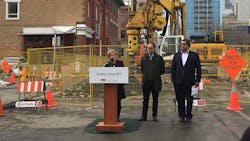Province of Alberta, Calgary sign funding agreement for Green Line project
The city of Calgary and the province of Alberta have signed a funding agreement that will allow for construction of the planned Green Line Light-Rail project to begin.
The project will ultimately add 46 kilometers (28.5 miles) of light-rail to the city's existing 59-kilometers (36.6-mile) light-rail network. The project will be built in stages with Stage 1 connecting Calgary's Crescent Heights neighborhood to Shepard along 20 kilometers (12.4 miles) with 14 stations.
The provincial government explains that the agreement locks in C$3 billion (US$2.28 billion) in funding, with equal portions from the provincial and federal governments. The funding will flow over eight years to support Stage 1 of the Green Line. In May 2018, the federal government confirmed it's commitment to provide C$1.53 billion (US$1.16 billion) to the project, which represented the largest investment in public transportation in Alberta's history. The total provincial contribution towards the Green Line is C$1.7 billion (US$1.29 billion).
“Calgary is one of North America’s great cities. It’s growing, it’s dynamic and this expanded transit project will help propel it into the future. The Green Line LRT is Calgary’s highest public transit infrastructure priority, and it’s a priority that our government is proud to support," said Alberta Premier Rachel Notley.
The Green Line is made possible through provincial funding raised through the Climate Leadership Plan. Revenue from the plan, including the carbon levy, is reinvested to grow and diversify Alberta’s economy and rebated to Albertans. Support for green infrastructure projects, like transit, are included.
"This is another important step in bringing this project to life. The Green Line will be the biggest infrastructure project in Calgary’s history, providing critical connections and supporting our city’s growth," said Calgary Mayor Naheed Nenshi.
The city of Calgary has already begun preparing the land that’s been set aside for the project. The city estimates that when Stage 1 is complete, it will reduce C02 emissions by 30,000 metric tons, every year – the equivalent of 6,000 vehicles.
About the Author

Mischa Wanek-Libman
Group Editorial Director
Mischa Wanek-Libman is director of communications with Transdev North America. She has more than 20 years of experience working in the transportation industry covering construction projects, engineering challenges, transit and rail operations and best practices.
Wanek-Libman has held top editorial positions at freight rail and public transportation business-to-business publications including as editor-in-chief and editorial director of Mass Transit from 2018-2024. She has been recognized for editorial excellence through her individual work, as well as for collaborative content.
She is an active member of the American Public Transportation Association's Marketing and Communications Committee and served 14 years as a Board Observer on the National Railroad Construction and Maintenance Association (NRC) Board of Directors.
She is a graduate of Drake University in Des Moines, Iowa, where she earned a Bachelor of Arts degree in Journalism and Mass Communication.
